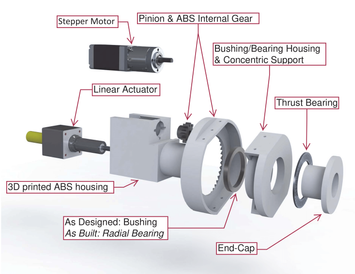ROBOTIC ARM
This section will briefly showcase my design of the rotating base and wrist, components for which I was responsible under the robotics branch of CSU: Fullerton's Titan Rover Team of 2016-2017.

The Rotating Base
Features: 360° rotation, Nema 23 stepper motor with 4:1 gearbox, water-jetted internal gear, thrust and radial bearings enclosed in steel casings.
The main consideration for my design was limiting the exposure of the moving parts and bearings to small rocks and debris. The operating environment would be the desert containing the Mars Desert Research Station, a few miles from Hanksville, Utah. The internal gear shields the moving parts, provides a comparable amount of torque to a normal gear, and isn't as heavy as a planetary gear system. In fact, all around, a large amount of material was removed by taking advantage of SolidWork's weight optimization and FEA packages.
Two bearings stabilize this system. One radial bearing centers the rotation, while an underside cap clamps the rotating platform against a thrust bearing from below. One additional gear sits opposite the motor's pinion gear for peace of mind.
The fixture that provides the foundation for mounting the arm is welded into the rotating top plate.
Finally, a hole in the center of the entire assembly allows for the passing of wires that feed and relay signal to the 6 motors above.

Unlimited Rotation Wrist
Features: Nema 11 stepper motor, Ametek Linear Actuator.
Note: My design concerned the interfacing that allowed the gripper to function, not the gripper itself.
Tasked with not only picking up bottles containing several gallons of water, but also unscrewing the caps, the gripper and wrist system needed to be capable of both clamping onto objects and rotating continuously. This translated to the main challenge of actuating two separate motors independently and without interference - the wires of the linear actuator needed to transmit power and signal without getting spun into the rotation of the stepper.
Materials:
The 3D printing process enabled the production of a light and durable wrist and gripper combination. Additionally, and perhaps equally as important, the speed of printing each component allowed for a quick succession of iterations. For my wrist component alone, I was able to print and test 7 prototypes and quickly adapt to several changes in requirements, exemplified with the following:
Perhaps the most exciting and difficult challenge I faced in the design of the wrist was when my team decided to change to a different stepper motor for increased torque. Not only did the spacial needs double in width, but the length of the motor itself nearly doubled with the addition of a gearbox.













